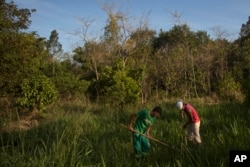Governments around the world have promised billions of dollars to replant trees on millions of hectares of poor land.
What is missing are the businesses to make this happen.
A new report by the World Resources Institute and the Nature Conservancy says it wants to solve this problem. The non-profit environmental organizations want to show that it is possible to make a profit from restoring deforested land.
Making a profit from trees
Experts say that demands on land and effects of climate mean the world needs every hectare possible to produce food, clean the air and water.
Forests also are important for easing the effects of greenhouse gasses blamed for warming the earth’s atmosphere.
A group of 47 countries have promised to restore an area of deforested land equal in size to Mongolia by 2020. African and Latin American investors have promised $2 billion for the project.
Sofia Faruqi is the lead author of the report. She said now it is important for the investors to act on their promises.
She said governments and non-government organizations cannot do everything. They also need investment from private businesses. This means profit must be involved.
The report brings attention to 14 companies that want to make money restoring land. The authors wanted business models that could create strong results.
New ways for new growth of trees
Brinkman Group is a tree-planting business based in Canada.
The Brinkman Group website says it has planted 1.4 billion trees on 1 million hectares of land. The company got its start replanting forests that had been clear-cut in Canada.
In the 1990s, Brinkman started growing trees on land in Central America were farmers had used slash-and-burn methods.
Brinkman created a forest environment with a mix of trees, including teak for furniture and flooring and rosewood for guitars. To protect the plant life, individual trees will be selected to be cut, not clear-cut, at harvest time.
Some kinds of trees are not usually grown to sell for a profit. It took years to learn how to grow these trees from cuttings.
The effort is starting to have some success after 20 years. The first harvests have begun, and company founder Dirk Brinkman says they are starting to make a profit.
“It’s a bit surprising for some looking at this, that this is possible,” Brinkman said. “But it takes time to prove.”
Other companies included in the report are lowering the cost of restoration.
BioCarbon Engineering flies drones that plant trees. Drones are faster and cheaper than replanting by hand, the company says. They can also go to difficult-to-reach places.
Other companies have invested to support their current products.
One example is Guayakí, a company that sells tea made from a plant that grows in the shade called yerba mate. The company says it has planted 500,000 trees in a deforested part of Brazil’s forest to shade its important crop.
Trees: a risky business
The report also includes some new business models.
A major cause of deforestation in Africa is the growing demand for building materials and charcoal.
To solve this problem, a company based in Kenya called Komaza gives small farmers tree seedlings to plant on unused parts of their land. When the trees mature in 10 to 12 years, Komaza says it will buy the trees back for a guaranteed price. The company then harvests, processes and sells the wood.
More than 9,000 farmers are raising more than 2 million trees for Komaza.
However, Komaza has not yet made a profit.
Ayesha Wagle is president of Komaza.
“Trees take a long time to grow,” Wagle said. She noted that the company could cut down a lot of trees immediately and make a profit.
But she added, “the longer we wait, the more valuable they are.”
The report’s author, Sophia Faruqi, says the long wait to make any money is one of the problems for some investors.
Wagle said there are many problems facing Komaza: “From rainy seasons that don’t appear, to poor roads that make it hard to truck trees to market.”
Other difficulties include unclear land ownership in many developing countries, which makes investing in farmers and land restoration risky. And government policy may change during the investment period, especially in developing countries.
The Brinkman Group said it got agreements with officials when it planted its tropical hardwood trees. “We were promised a tax-free harvest,” he said.
But the situation changed after many years. “Twenty years later, the bureaucracy is going, ‘No, no, we tax logging.’ And we’re going, ‘No, no, we’ve got a grandfathered agreement.’ ‘Oh, well, we don’t have a copy of that agreement anymore.’”
It took Brinkman several years to fix this dispute.
Mushfiq Mobarak, an economics professor at Yale, says that the idea of making money from planting trees is still very new. He said there is not a lot of information about the possible risks and returns.
Mobarak said he is pleased the report gave ideas for business models. But he notes that, since the information comes from the companies themselves, more independent research is needed.
I’m Phil Dierking.
Steve Varagona originally wrote this story for the VOANews.com. Phil Dierking adapted this story for VOA Learning English. Mario Ritter was the editor.
Can you think of other business models for making a profit planting trees? We want to hear from you. Write to us in the Comments Section or on our Facebook page.
_____________________________________________________________
Words in This Story
bureaucracy - n. a large group of people who are involved in running a government but who are not elected
charcoal - n. a hard black material that is made by burning wood with a small amount of air
clear-cut - v. to cut down all the trees in (an area)
cuttings - n. a stem, leaf, or root that is cut from a plant and used to grow a new plant
drones - n. a type of small aircraft that flies without a pilot
grandfather - n. is a provision in a law or contract that allows old rules to continue to apply in certain situations.
mature - v. to continue developing to a desired level
restore - v. to return (something) to an earlier or original condition by repairing it, cleaning it, etc.
seedling - n. a young plant that is grown from seed
shade - v. an area of slight darkness that is produced when something blocks the light of the sun
slash-and-burn - v. done by cutting down and burning trees and plants in order to clear an area of land and grow crops on it for usually a brief time








